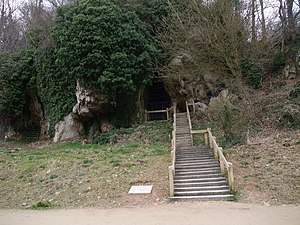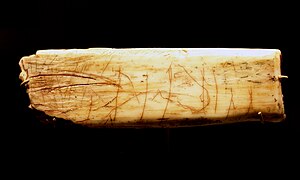Difference between revisions of "Robin Hood's Cave, Creswell Crags"
(Created page with "{{Infobox cave |name=Robin Hood's Cave |county=Nottinghamshire |picture=Robin Hood Cave, Creswell Crags - geograph.org.uk - 1175963.jpg |picture caption=Entrance to Robin Hood...") |
m (→References) |
||
| Line 34: | Line 34: | ||
*[https://www.britishmuseum.org/research/collection_online/collection_object_details.aspx?objectId=1362233&partId=1&searchText=creswell+horse&page=1 British Museum exhibit article] | *[https://www.britishmuseum.org/research/collection_online/collection_object_details.aspx?objectId=1362233&partId=1&searchText=creswell+horse&page=1 British Museum exhibit article] | ||
| − | [[Category: | + | [[Category:Creswell Crags]] |
Latest revision as of 21:43, 3 June 2016
| Robin Hood's Cave | |
| Nottinghamshire | |
|---|---|
 Entrance to Robin Hood's Cave | |
| SK53547421 | |
| Co-ordinates: | 53°15’43"N, 1°11’57"W |
Robin Hood's Cave is the largest cave in the Creswell Crags, a limestone gorge and archaeological treasure house forming part of the border of Nottinghamshire with Derbyshire. The cave is found in the cliff-face on the northern, Derbyshire side.
The cave is the largest here and in the wider limestone area. It has four main chambers are linked together by short passages.
The Creswell Crags are rich in Stone Age artefacts and Robin Hood's Cave is no exception: how many generations dwelt in the cave can never be known but they left their mark, the most remarkable find being the a carved bone known as the Robin Hood Cave Horse.
Archaeology
Several archaeologists dug here starting with the Victorian antiquarians, Revd Magens Mello, Thomas Heath and Professor W.Boyd Dawkins, in 1875 and 1876 and Robert Laing before 1889. Mello, Heath and Dawkins concentrated their work in the western chamber and took just over a month to remove most of the cave deposit, while Laing removed deposits from the both the central and rear chamber and possibly the eastern chamber: archaeologists were not so detailed in their records in that generation.
In 1969, John Campbell carried out a small-scale excavation in the entrance area and in 1981, Rogan Jenkinson directed excavations on remnants of deposits left by earlier archaeologists.[1]
Robin Hood Cave Horse
The Robin Hood Cave Horse is a fragment of rib engraved with a horse's head, discovered in the cave during the 1876 excavation. It is the only piece of Upper Paleolithic portable art showing an animal to have been found in Britain.[2][3][4] It now lies in the British Museum, but is normally not on display.
A replica of the artefact is displayed at the Creswell Crags Museum.
The horse's head is clear and well executed, and it was the first image to be engraved on the rib. Later, vertical lines are overlaid across the body and in front of the horse: the overall effect creates an impression of a palisade, fence or even falling spears. If this is the case, we might be seeing a scene in which horses are guided by a wooden structure—maybe for hunting purposes. The deeply scored horizontal lines[5] behind and over the horse were drawn last. They appear frenetic and may constitute a form of erasure. Similar, but more curved, lines are also present on the other side of the rib.
References
- ↑ Cresswell Crags: Robin Hood’s Cave
- ↑ British Museum (2011). "British Museum – Horse engraving on bone". britishmuseum.org. http://www.britishmuseum.org/explore/highlights/highlight_objects/pe_prb/h/horse_engraving_on_bone.aspx. Retrieved 14 October 2011.
- ↑ British Museum; Ann Sieveking (1987). A catalogue of palaeolithic art in the British Museum. Published for the Trustees of the British Museum by British Museum Publications. pp. 112–. ISBN 978-0-7141-1376-0. https://books.google.com/books?id=DtCfAAAAMAAJ&pg=PA112. Retrieved 14 October 2011.
- ↑ Pettitt, P B (2003). "Discovery, nature and preliminary thoughts about Britain's first cave art Capra 5". capra.group.shef.ac.uk. http://capra.group.shef.ac.uk/5/pettitt.pdf. Retrieved 14 October 2011.
- ↑ British Museum image
- National Heritage List 1003770: Robin Hood's Cave
- Megalithic Portal: Robin Hood's Cave
- National Monuments Record: No. 891376 – Robin Hood's Cave
- British Museum exhibit article
